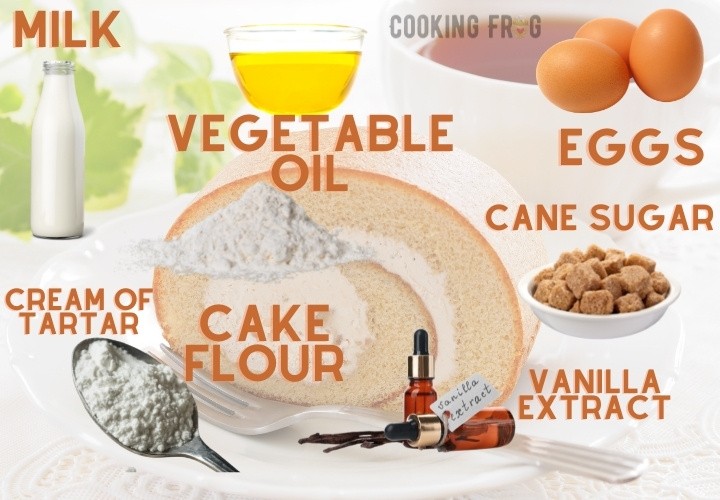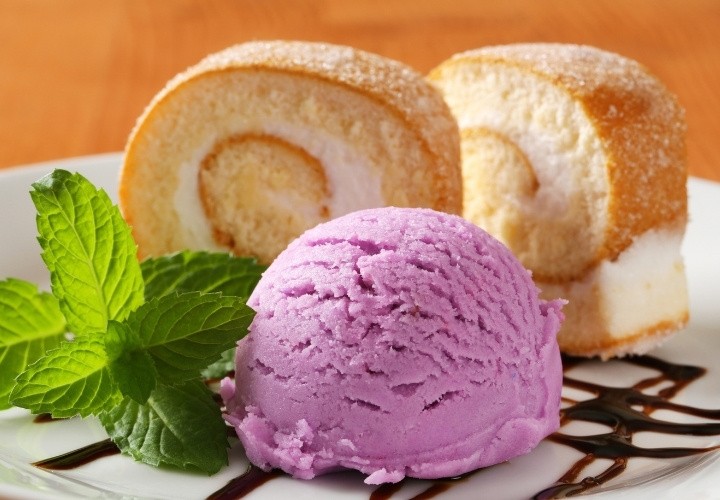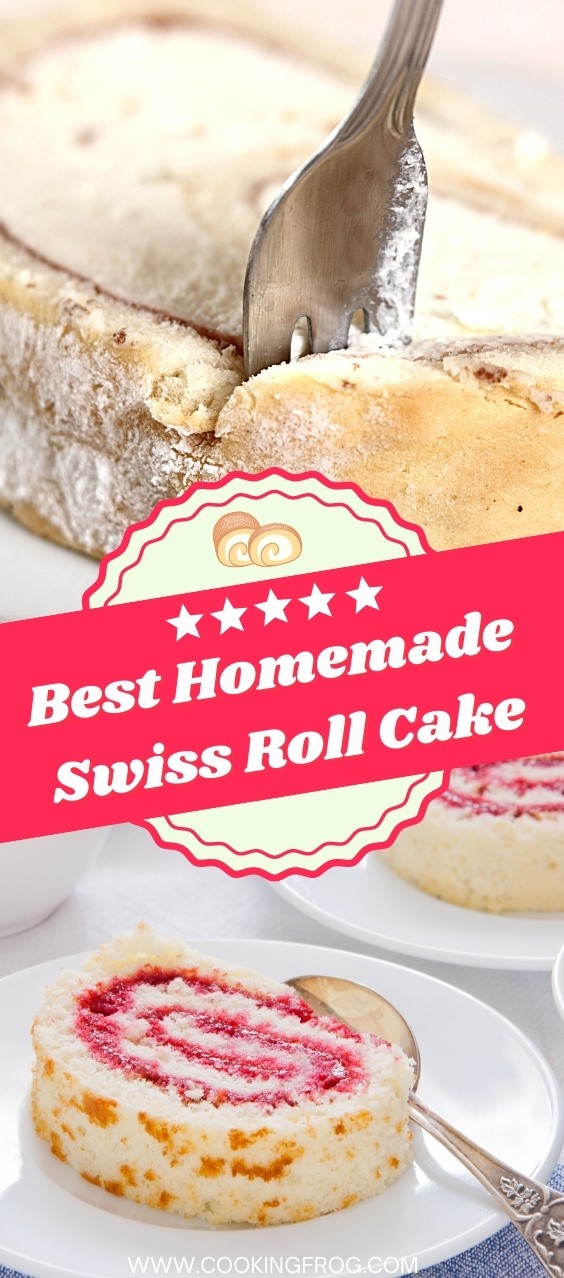This recipe for the ultimate Swiss roll cake yields a dessert that is not overly sweet and is delicate, fluffy, and spongy. Use whipped cream, jam, or ganache to fill this chiffon-style cake, which is easy to make with the advice I’ve provided below.
Childhood favorites are among the best dishes, as is well known. This recipe for airy, tender Swiss roll cake is fantastic! It’s a stunning cake that would amaze any gathering and isn’t as difficult to make as it seems!
This is the best Swiss roll cake recipe—I don’t intend to sound arrogant! Not only does it taste fantastic, but it also looks stunning and is really simple to make! Valentine’s Day, Mother’s Day, Christmas, or any other special occasion, this Swiss roll cake would be ideal!
This Homemade Swiss Roll Cake is one of my favorite desserts to bake and enjoy. Personally, I love airy cakes, and it’s not a secret they are my favorite. As long as you adhere to the advice I’ve provided below, making Swiss roll cakes is actually fairly simple.
What is a Swiss Roll Cake?
Roll cake, Jelly roll cake, cream roll cake, and Swiss log cake are further names for Swiss roll cake. (A variant that normally occurs around Christmas is the “Buche du Noel” or yuletide log.) In essence, it is a sponge cake wrapped up with whipped cream, chocolate ganache, or jelly as the filling.
The History of Swiss Roll Cake
Ever ponder the origins of some of these desserts? Such as cake rolls or roll cakes, as well as its varieties like Swiss roll cake or jelly roll cake? Ever wonder how certain tastes, like chocolate cake rolls or strawberry rolls, were started? It’s interesting stuff to ponder while savoring the delightful little cake.
Roll cakes, also known as Swiss rolls or cake, are desserts that resemble sponge cakes and are rolled with fillings. They are sometimes served with whipped cream. They are occasionally referred to as Swiss roll cakes. Strangely enough, that designation does not apply to the other desserts that are classified as roll cakes.
Even though there is some disagreement on where the roll cake, swiss roll cake, and its cousins originated, everyone can agree that it was in Europe. Almost everyone, I suppose. Who cares? You could be asking yourself. They taste great! True; however, it’s important to verify whether the roll cakes you’re eating are from a restaurant that claims to solely provide real and traditional European food. Take Sicilian Cannoli, for example (we’ve talked about them, and you can check the recipe); they are very important to Italians, especially Sicilians.
Nobody is completely certain which is the frankest and shortest response. When a recipe for a sponge cake with jelly smear was published in upstate New York in 1852, it is believed that this is when the roll cake or jelly roll was first used.
The recipe, titled “To Make Jelly Cake,” depicts a contemporary “jelly roll” and says to bake quickly and apply jelly while it’s still hot. Roll it gently, then cover it with a cloth. Slices should be made for the table while cold.
The vocabulary used in the US has evolved through time. From 1852 until 1877, this delicacy was known by the titles Jelly Cake, Roll Jelly Cake, Swiss Roll, Jelly Roll, and Rolled Jelly Cake (1876). It didn’t take long for the nickname “Jelly Roll” to spread.
All around Europe, similar recipes have been discovered; while the fillings have changed, the names have remained constant. Food is strangely like an oral tradition.
When it comes to the Swiss roll, one thing is for certain: it wasn’t invented in Switzerland. In contrast to its northern cousin, the roll cake or Swiss roll, historic English recipes precede them.
France, Austria, Germany, and Hungry have been recommended by certain food experts. It may be discouraging to think that the creator of the exquisite dessert may never be found, but kudos to whoever did. Why this Swiss Roll Cake Recipe is great
This Swiss roll cake recipe has been proven and tested in our household for many years. The cake is not too sugary and is light in texture, moist and fluffy. Only a few simple ingredients are needed, together with an equal amount of egg yolks and whites. (A lot of recipes call for more egg whites than yolks.)
Ingredients required for Swiss Roll Cake
A swiss roll cake contains the following ingredients:
Eggs: the yolks and whites are separated and beaten separately, and the egg whites provide the cake its leavening. The eggs should first be separated; then, they should be allowed to warm up at room temperature.
Milk: You may use whatever sort of milk you have on hand as whole milk.
Cane Sugar: Granulated cane sugar, divided into equal portions for the egg white and yolk mixtures.
Cream of tartar: A cream of tartar is an acid that aids in keeping whipped egg whites stable. If you don’t have a cream of tartar, you may use some vinegar or lemon juice.
Vegetable oil: I prefer avocado oil for cooking, but you may use any light vegetable oil. This gives the cake moisture and elasticity.
Vanilla extract: Vanilla extract, or for variety, you can use any other flavor.
Cake flour (pastry flour): Less protein and gluten are present in this type of flour, which keeps the cake soft.
How to make Swiss Roll Cake?
Getting the eggs ready
The eggs must first be taken out of the refrigerator, and the egg whites and yolks separated, as was previously indicated. Why? When the eggs are cold, it is simpler to separate the egg whites from the yolks. To get enough volume during the beating, the egg whites must be at room temperature.
Make sure your basin is clean and free of oil before beginning to beat the egg whites. The egg whites’ ability to whip up well can be hampered by oil. A quick clean with a paper towel and some lemon juice or vinegar before adding the egg whites is a simple method to do this.
Prepare the egg yolk mixture.
2 Tablespoons (30g) of sugar and the egg yolks should be combined and whisked in a separate bowl. Whisk one more before adding the oil, milk, and vanilla extract.
The egg yolk mixture should be sifted over the cake flour and gently folded in until there are no lumps.
Beat the egg whites.
Add the egg whites at room temperature to a clean stand mixer bowl with a whisk attachment. Activate the mixer at a low speed.
Add a small amount of cream of tartar (you can also use vinegar or lemon juice) after the egg whites are frothy and bubbling. Slowly add the granulated sugar as you gradually increase the mixer’s speed.
The egg whites should be whipped until they are glossy, fluffy, and attain a gentle peak. (At the end of the whisk, the egg whites will create a curving tail.)
Combine the Swiss Roll Mixture
Fold roughly one-third of your egg whites into the mixture of yolks using a spatula. The egg yolk batter will become more fluid as a result. Note that folding differs from stirring.
To avoid deflating the beaten egg whites, you need to use less force. To fold, lower the spatula to the mixture’s bottom and scoop it up with a gentle flick of the wrist while you rotate the bowl by about 90 degrees. Fold and tilt the bowl as necessary to nearly completely homogenize the mixture.
When the egg whites are well absorbed into the batter, add the remaining third of the egg white mixture. Be careful not to overmix, or the egg whites will lose their volume.
Bake the Swiss Roll Cake
Put parchment paper on a 9″ by 13″ baking sheet. Turn the oven on to 375°F and spread the batter onto a baking pan (9 inches by 13 inches).
To get rid of any air bubbles that are trapped, tap the tray a few times. Bake the cake for 13–15 minutes at 375°F or until the top is dry, golden brown, and bouncy to the touch.
The cake should be taken out of the oven and dropped from a height of one foot right away. By doing this, the cake won’t shrink.
Allow the cake to chill on a cooling rack for 10 to 15 minutes, just long enough for it to become slightly warm but not frozen.
Make the Whipping Cream
Make the whipped cream while the cake is resting. Using a bowl that has been cold in the refrigerator can help the cream whip up properly.
The heavy cream should be poured into the cold basin along with the powdered sugar and whisked to firm peaks. (Avoid overwhipping; it will cause the cream to become butter.)
How to Roll Swiss Roll Cake?
- Place the upper side of the slightly warm cake down on a large sheet of parchment paper (the browned exterior). It goes without saying if you’d like, you may decide to roll it the other way.
- Place some whipped cream on top of the cake. The whipped cream should be applied to the whole cake using an offset spatula.
- Roll up the cake carefully, beginning at the short end using the parchment paper as support.
- To get the roll taut, use the parchment paper to push it slowly.
- Seal the parchment paper ends after ensuring the seam side is downward.
- In order to firm up, place the cake on a pan and refrigerate for at least 5 hours.
How to Serve Swiss Roll Cake?
The Swiss cake portions should ideally be sliced when you are ready to eat. Slice the ends of the cake with a sharp serrated knife after removing it from the refrigerator. With a warm, wet cloth, clean the knife.
Slice the cake into pieces that are about an inch thick, wiping the knife between each slice. Serve the cake plain or with fresh fruit. If you added a scoop of ice cream, that would be fantastic.
How to Store Swiss Roll Cake?
The Swiss roll cake should be refrigerated in an airtight container. If a filling besides whipped cream is being used, the cake can be kept at room temperature for up to 48 hours (in an airtight container).
Cake slices can also be sliced into pieces and frozen in separate freezer bags. For up to three months, freeze. Simply let the cake come to room temperature before serving if serving from the freezer.
Swiss Roll Cake Variations
Whenever I make a new kind of cake, I always turn to this Amazing Swiss Roll Cake recipe and play with the ingredients.
- Raspberry Roll Cake
- Earl Grey Blackberry Cream Roll Cake
- Chocolate Roll Cake
- Chocolate Mousse Cake Roll
- Cream-Filled Roll Cake
- Hojicha Roll Cake
- Swiss Roll Cake – Snow White
Change the flavor of the vanilla extract or experiment with the filling flavors. There are countless options!
In the past, I’ve made blackberry cream and a filling using fresh mango fruit.
It would be excellent to make blueberry jam, chocolate ganache, or even matcha chocolate cream.
Share the image below to your Pinterest board if you like this Swiss Roll Cake Recipe!
Swiss Roll Cake Recipe
Ok, now that we know everything we need to know about this amazing European Roll Cake (as we’ve determined that it doesn’t originate from Switzerland) we can start making it with the detailed instructions below.
Prep Time: 30 Minutes
Cook Time: 15 Minutes
Cooling Time: 5-6 hours
Ingredients
For the Cake:
- 3 egg yolks
- 2 TBSP of granulated cane sugar
- 2 TBSP of avocado oil or any light vegetable oil
- 2 TBSP of whole milk
- ½ tsp of vanilla extract
- 4 TBSP of cake flour sifted
- 3 room-temperature egg whites
- ¼ tsp of cream of tartar
- 2 TBSP of granulated cane sugar
Whipped Cream:
- ½ Cup of heavy whipping cream
- 1 TBSP of powdered sugar
Instructions
- Line a 9 by 13-inch baking sheet with parchment paper.
- Divide the egg yolks and whites into two separate bowls. Ensure your bowl is clean and free of oil before beating the egg whites. Before adding the egg whites, quickly wash the bowl and whisk with a paper towel and a little lemon juice or vinegar.
- Set the oven to 375 °F / 190 °C.
- Whisk together the egg yolks and 2 Tablespoons of sugar. Whisk one more before adding the oil, milk, and vanilla extract.
- Add the cake flour by sifting it on top of the egg yolk mixture and whisking until there are no lumps.
- Add the egg whites at room temperature to a clean stand mixer dish with a whisk attachment.
- Switch the mixer on at a slow speed.
- When the egg whites start to foam and bubble, add some cream of tartar (alternatively, you can add vinegar or lemon juice).
- Slowly add the granulated sugar while gradually increasing the mixer’s speed.
- Whip the egg whites continuously until they are glossy and fluffy, and achieve a soft peak. (At the end of the whisk, the egg whites will create a curving tail.)
- Gently fold roughly one-third of the egg whites into the egg yolk mixture using a spatula. The egg yolk batter will become more fluid as a result.
- Hint: Folding differs from stirring. To avoid deflating the beaten egg whites, you need to use less force. To fold, lower the spatula to the mixture’s bottom and slowly flick your wrist upward while rotating the bowl by roughly 90 degrees. Fold and tilt the bowl as necessary to nearly completely homogenize the mixture.
- Fold the remaining third of the egg white mixture into the combination of egg yolks. Fold the rest of the egg white mixture into the batter until it is completely integrated, being careful not to overwork the egg whites, or they may lose their volume.
- Spread the cake batter onto a parchment-lined 9 by 13-inch baking sheet.
- Tap the tray a few times to let any air bubbles that may have been trapped escape.
- Bake the cake for 13 to 15 minutes at 375°F or until the top is golden brown and firm to the touch. When touched with a fingertip, the cake ought to spring back.
- After taking the cake out of the oven, dump it from a height of 1 foot right away. By doing this, the cake won’t shrink.
- Place the cake on a cooling rack and let it cool for 10 to 15 minutes, just long enough for it to become slightly warm but not entirely cold.
For The Whipped Cream
- Prepare the whipped cream while the cake is chilling.
- Hint: The cream will whisk up more easily if you use a cooled bowl (from the refrigerator).
- Place the powdered sugar in the cooled bowl with the heavy cream, then whisk to firm peaks. (Avoid overwhipping; it will cause the cream to become butter.)
Assembling the Swiss Roll Cake
- Place the top-side-down cake on a large sheet of parchment paper while it’s still warm (the exterior has browned). Naturally, you have the option to roll it to the other side if you prefer.
- Spread the whipped cream over the cake’s top. (At this stage, you might want to add some fruits like mango, banana, or whatever you like)
- To uniformly distribute the whipped cream over the whole cake, use an offset spatula.
- Begin by rolling up the cake carefully using parchment paper, beginning at the short end.
- Gently press the roll taut using the parchment paper.
- Seal the parchment paper’s ends, making sure the seam side is downward.
- Put the cake on a tray and refrigerate for at least 5 hours to harden it up.
- Use a serrated knife to trim the cake’s ends. In between cuts, wipe the knife with a warm, wet cloth. Slice thickly, then serve.
FAQs
Why did my Swiss Roll Cake crack?
You could have overwhipped the egg whites, in which case. When you pull out the whisk, the egg meringue should have a “tail,” which indicates that the peaks are soft.
There’s also a chance that you overbaked the cake. Simply continue to bake the top until it seems dry and springy. A cake that has been overbaked will be dry and may crack as a result.
How much cream do I need for the Swiss Roll Cake?
For the filling, you’ll need roughly 12 C (125ml) of heavy whipping cream. If you like a thicker cream layer, you may add extra without a doubt.
The top layer of my cake is stuck to parchment paper.
If the top layer of your cake gets stuck on parchment, it may indicate that the cake needs a few extra minutes in the oven to finish baking.
Dry and resilient when softly pushed, the surface should not be moist.
Nutrition
- Calories: 179kcal
- Carbohydrates: 16g
- Protein: 4.3g | Fat: 11.9g
- Saturated Fat: 4.9g
- Cholesterol: 94mg
- Sugar: 8.5g
- Sodium: 29mg
- Potassium: 68mg
- Fiber: 1g
- Vitamin C: 1.5mg
- Vitamin A: 341IU
- Calcium: 28mg
- Iron: 1mg







